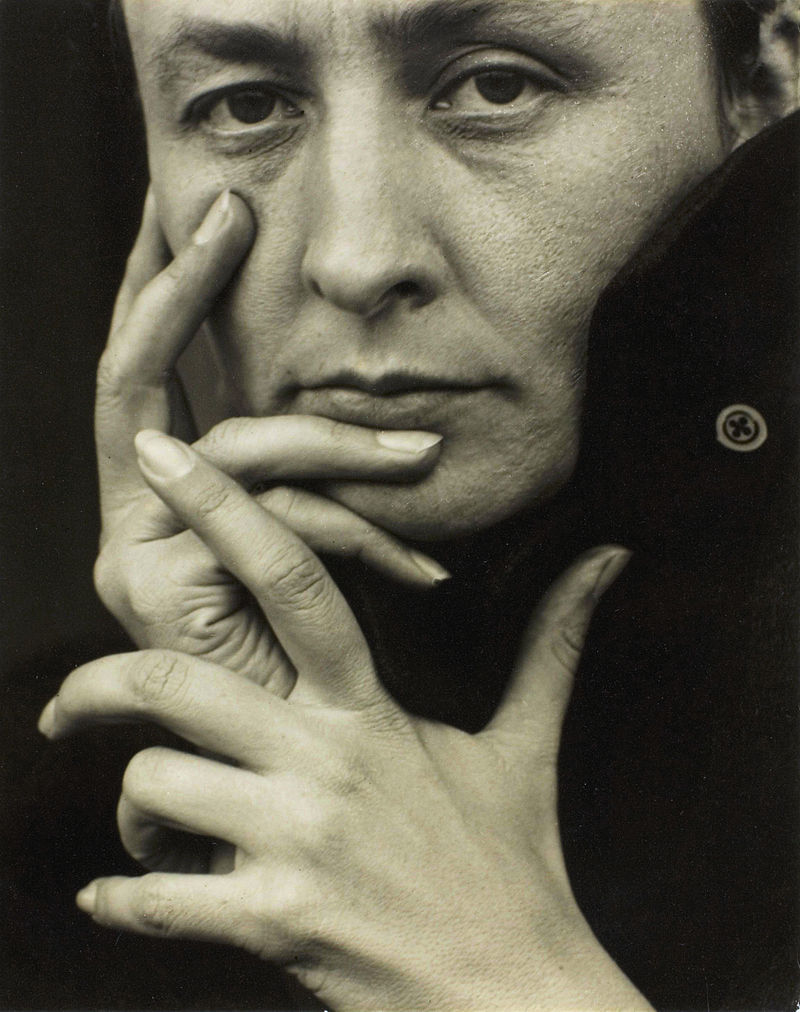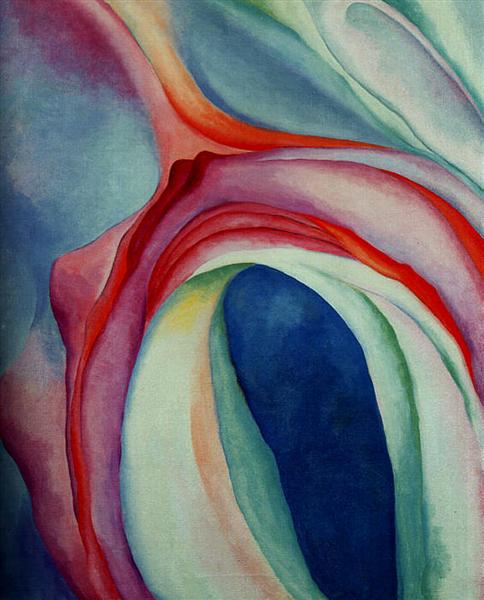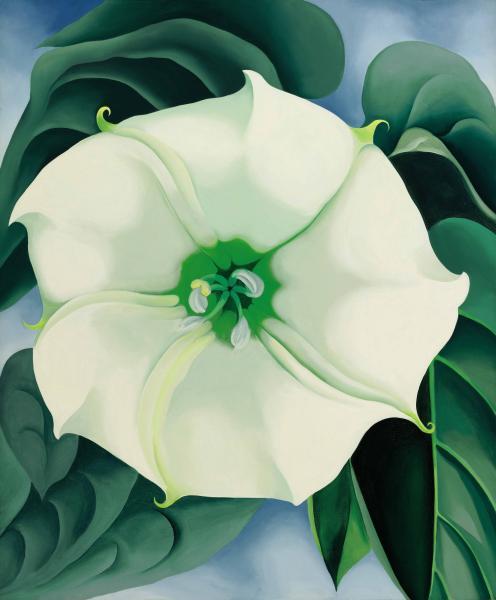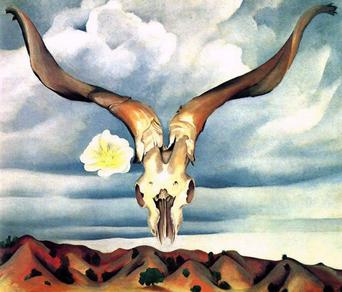The Mother of American Modernism
When we think of Georgia O’Keeffe we immediately think of her enlarged flowers, animal skulls, New York skyscrapers, and New Mexico landscapes. Her inimitable style earned her the distinction of being referred to as the “Mother of American Modernism”.
This article is part of a series about women artists in coordination with the Manhattan Arts International “HerStory” 2018 online exhibition.

Born in Wisconsin in 1887, her parents, Francis Calyxtus O’Keeffe and Ida (Totto) O’Keeffe, were dairy farmers. She attended Town Hall School in Sun Prairie. A quiet and independent child, at age ten she had decided to become an artist. She and her sister received art instruction from local watercolorist Sara Mann.
After studying at the School of the Art Institute of Chicago she attended the Art Students League in New York, studying under William Merritt Chase. There, she felt bored and constrained by the lessons that focused on recreating or copying what was in nature. She wanted to follow her own innate voice.
In 1908, unable to fund further education, she took a job as a commercial illustrator which lasted for two years. From the years 1911 to 1918 she was a teacher in Virginia, and South Carolina and head of the art department at West Texas A&M University. It was at that time that she became acquainted with the Palo Duro Canyon and the landscape soon became an iconic reference within her work.
 Georgia O’Keeffe, Music Pink and Blue, 1918. Photo: Public domain.
Georgia O’Keeffe, Music Pink and Blue, 1918. Photo: Public domain.
While O’Keeffe was teaching she was also producing charcoal drawings and watercolors, some of which were seen by Alfred Stieglitz, a 52 year old successful photographer who owned the 291 Gallery in New York City. He was struck by the sincerity in her work and produced her first solo show in 2017 It was comprised of oil paintings and watercolors which she completed in Texas.
O’Keeffe and Stieglitz were married in 1924. In the beginning their relationship was passionate. They wrote each other love letters, sometimes two and three a day, some of them 40 pages long.
After their marriage, O’Keeffe became part of an inner circle of American modernist painters who frequently showed in Stieglitz’s gallery. Her work shifted towards oil paintings which appeared to be magnified natural forms. They were large-scale depictions of flowers, as if seen through a magnifying lens. By magnifying her subject, she emphasized shape and color and brought attention to the tiny details within the flower.
Her first large-scale flower painting, was titled “Petunia, No. 2”, in 1924, and it was first exhibited in 1925 in New York City. Her exploration on the flower theme continued throughout her career. She artist created a total of about 200 flower paintings.
 Georgia O’Keeffe, Jimson Weed, White Flower #1, oil on canvas, 48″ x 40″. Crystal Bridges Museum of American Art, Bentonville, AR.
Georgia O’Keeffe, Jimson Weed, White Flower #1, oil on canvas, 48″ x 40″. Crystal Bridges Museum of American Art, Bentonville, AR.
In 2014 O’Keeffe’s painting “Jimson Weed, White Flower #1”, shown above, sold for a staggering $44.3 million. It was recorded as the highest price paid for a work of art by a woman artist.
About her flower paintings O’Keeffe stated, “When you take a flower in your hand and really look at it, it’s your world for the moment. I want to give that world to someone else… Nobody really sees a flower – really – it is so small – we haven’t time – and to see takes time… So I said to myself – I’ll paint what I see – what the flower is to me but I’ll paint it big and they will be surprised into taking time to look at it.”

In 1929, seeking solitude and an escape from a crowd that perhaps felt artistically and socially oppressive. She traveled to New Mexico and fell in love with the visual scenery of the state. She became increasingly interested in the forms of animal skulls and the southwest landscapes. Her letters to Steiglitz reflected her colorful adventures and optimism. Back in New York, Stieglitz, at the time was 65, falls apart. “I am broken,” he writes, desperate that he has lost her and will never get her back.
For 20 years O’Keeffe spent part of every year working in New Mexico, where she found solace. Her popularity continued to grow and so did the value of her paintings in the New York galleries.
O’Keeffe was featured in two one-woman retrospectives at the Art Institute of Chicago and the The Museum of Modern Art in Manhattan in the 40’s. She was the first woman to ever have a retrospective at MoMA. She developed obsessive interest in formations of rock near her home in New Mexico and spent hours painting in sun and wind.
During the 1940s, Georgia O’Keeffe made an extensive series of paintings of what is called the “Black Place”, about 150 miles west of her Ghost Ranch house. O’Keeffe said that the Black Place resembled “a mile of elephants with gray hills and white sand at their feet.” She made paintings of the “White Place”, a white rock formation located near her Abiquiú house.
Shortly after O’Keeffe arrived for the summer in New Mexico in 1946, Stieglitz suffered a cerebral thrombosis. She immediately flew to New York to be with him. He died on July 13, 1946.
O’Keeffe continued an active life traveling to Europe and creating works of art. During her late 90’s she became increasingly frail. She moved to Santa Fe in 1984, where she died on March 6, 1986 at the age of 98. Her body was cremated and her ashes were scattered, as she wished, on the land around Ghost Ranch.
According to the book “Georgia O’Keeffe at Home” written by Alicia Inez Guzman, and available on Amazon, O’Keeffe was a generous member of her community. She donated money to the Presbyterian Church, supported local students who went to college and underwrote the construction of the local public school’s gymnasium. The author wrote, “She was a mentor to many, if difficult and high minded in everything she did.”
A substantial part of her estate’s assets were transferred to the Georgia O’Keeffe Foundation, a nonprofit. The Georgia O’Keeffe Museum opened in Santa Fe in 1997.
Update: “Georgia O’Keeffe: Visions of Hawai’i” is an exhibition at the Brooklyn Botanical Garden, in Bronx, NY, through October 28, 2018. In 1939 O’Keeffe was offered an all-expenses paid trip to Hawaii and was commissioned by Dole to create promotional advertisements. During her nine week stay she completed 20 paintings. This exhibition features the artist’s little-known depictions of the Hawaiian Islands and the plants and landscapes that inspired them. For more information about this exhibition visit .nybg.org
PLEASE SHARE
[feather_share show=”facebook, twitter, linkedin, pinterest, mail” hide=”reddit, tumblr, google_plus”]
Wonderful article, Renee. O’ Keeffe is one of my favorite artists. I loved visiting her museum in Santa Fe and visiting Taos, where she often spent time. Not as widely known about her is the time she spent in Hana, on Maui, doing paintings for Dole, as well as some of her own work, depicting Hawaii’s flora. Thanks for a wonderful article. I sure hope I can get back into my home so that I can paint something for the “Her Story” exhibit. Aloha!
Thank you Linda for your comment and for that interesting fact about her spending time in Hana on Maui. It makes sense as the flowers are so unique and beautiful in Hawaii. I hope you can return to your home soon. Oh, I’ve extended the deadline for HerStory until Sunday, June 10. Stay well and safe!